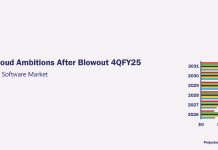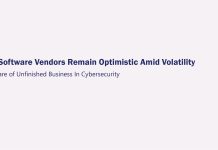The Cloud applications market in 2016 grew more rapidly than previously expected, suggesting that the gap between revenue bookings and revenues being recognized might be narrowing.
Historically, the Cloud applications market has been undercounted because of the lag effect between revenue bookings and revenues being recognized was too big to ignore. Some vendors might report triple-digit increases in the former, while similar uplifts in their reported revenues would not be showing up until a few years down the line.
Now with improved go-live methodologies as well as larger-than-ever installations that allow vendors to monetize more subscribers than ever, the Cloud applications market may be experiencing growing momentum through 2021.
Here are the differences between the Cloud applications market projections between August 2016 and May 2017 based on our research findings on Cloud Top 500, which represents more than 500 biggest Cloud applications vendors in the world and their 2016 Cloud applications revenues.
Other prevailing trends in the Cloud applications market are as follows:
- M&A continues unabated. The Cloud applications market saw at least 122 major deals among the top 500 vendors since the beginning of 2016. Just last week, ERP heavyweight Infor announced the purchase of Cloud Business Intelligence specialist Birst as it doubled down on the Cloud BI market after buying Predictix in 2016. The June 2016 deal by Microsoft to buy LinkedIn for its HCM and CRM solutions for $26 billion topped all transactions in the Cloud applications market, suggesting that acquirers are aiming higher and higher.
- Insourced vs. Outsourced Cloud. The Cloud applications market has climbed to $57 billion in 2016 from $1.5 billion a decade earlier as executive users from CFOs to corporate technologists in IT have poured a sizable amount of their budgets into internally developed Cloud projects. That has led to an unprecedented demand for Cloud infrastructure services, a trend that has propelled the likes of Amazon Web Services, Microsoft Azure and others. The tug-of-war between the insourced Cloud(spinning their own Cloud apps with the help of AWS and Azure) and the outsourced Cloud(deriving immediate value from commercially available Cloud apps like Salesforce) will be one of the most significant developments of corporate computing.
- Emerging ecosystems eclipse straight Cloud sales. In order for most Cloud applications vendors to ride out the competitive crosscurrents and a potential industry shakeout, the need to develop a sustainable ecosystem with an open and scalable platform that supports hundreds or even thousands of different Cloud apps from partners is greater than ever. Some of these apps are simple but essential in terms of driving new types of transactions such as IoT sensor as a service on top of a Cloud-based point-of-sale system, resume-parsing on top of a HCM platform, or payment processing on top of an ERP foundation. Whoever develops such a full-blown Cloud ecosystem the fastest may own bigger mind and market shares than the rest combined.
- That’s where Cloud replatforming will come in handy. The future of the Cloud applications market will be predicated on such an all-encompassing ecosystem since it just makes it easier and more convenient for buyers and suppliers to share and leverage strength from one another. A possible scenario emerges with any cloud subscriber poring over a tablet to access a financial management app, which immediately triggers a playlist of other options like payment processing engines, real-time inventory management integrations as well as other useful add-ons to consider. The question is who owns the playlist, what gets to be placed on the playlist and how sharable is the playlist. All these thorny but inevitable issues will arise as the enterprise playlist could become the catalyst behind the replatforming of the Cloud in order to make it more useful, intuitive and all-encompassing.
On May 10, I will be discussing the latest Cloud applications market-sizing data and industry trends along with my fellow presenters Larry Begley, CFO of CloudHealth, a fast-growing IT service management that optimizes use of the Cloud; Alan Rich, CEO of Chrome River, which specializes in Cloud-based travel and expense management applications; as well as financial management guru and popular podcaster Jack Sweeney, founder of CFO Thought Leader.
Our presentations will focus on common challenges facing finance executives, who now wield considerable influence over what companies spend in the Cloud, as they evaluate Cloud benefits by striking the delicate balance between the insourced and the outsourced Cloud as I alluded to earlier. We will also expound upon the tangible benefits of innovative Cloud applications from vendors like Chrome River, the latest Cloud market data from the global research team of Apps Run The World, as well as the overall industry perspectives from CFO Thought Leader. You can register for the webinar here.
Live attendees of this webinar will also receive a hardcover edition of the Amazon bestseller “To Pixar and Beyond: My Unlikely Journey with Steve Jobs To Make Entertainment History” by Pixar’s CFO-emeritus Lawrence Levy and the finance executive Steve Jobs hand-picked to join the animation studio as they worked closely to take the company public culminating in its sale to Disney for $7 billion.
I hope that you can join us for this exciting Webinar, pick up this fascinating book along with our take on the Cloud marketplace and how it shapes the future of critical functions like corporate finance.






